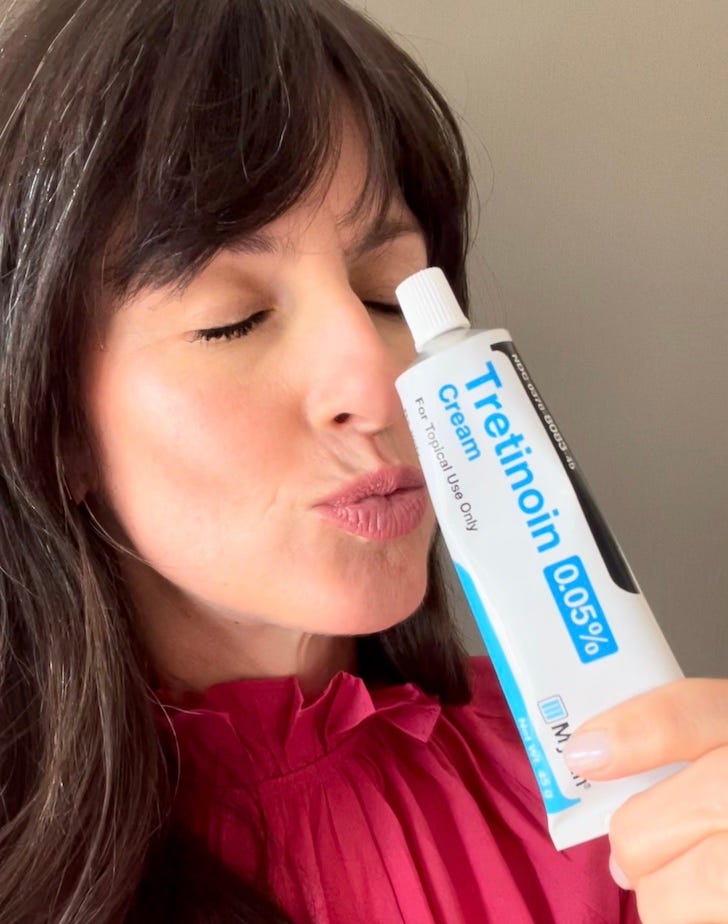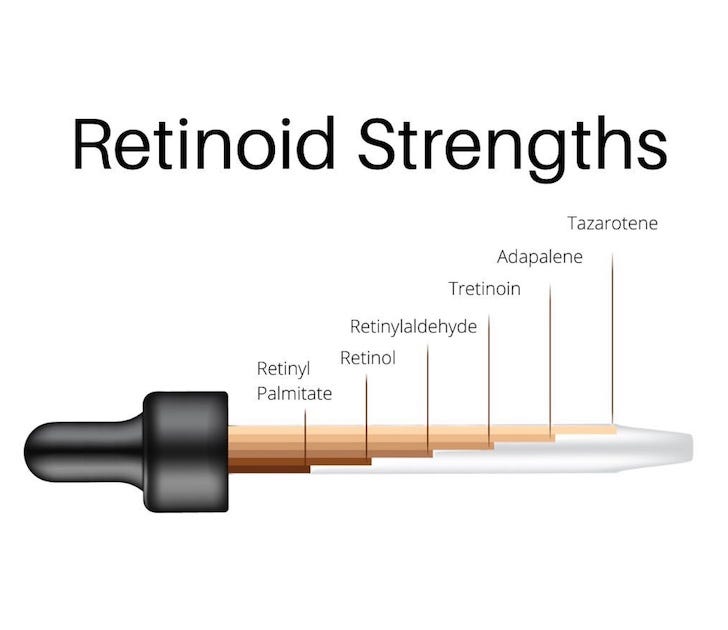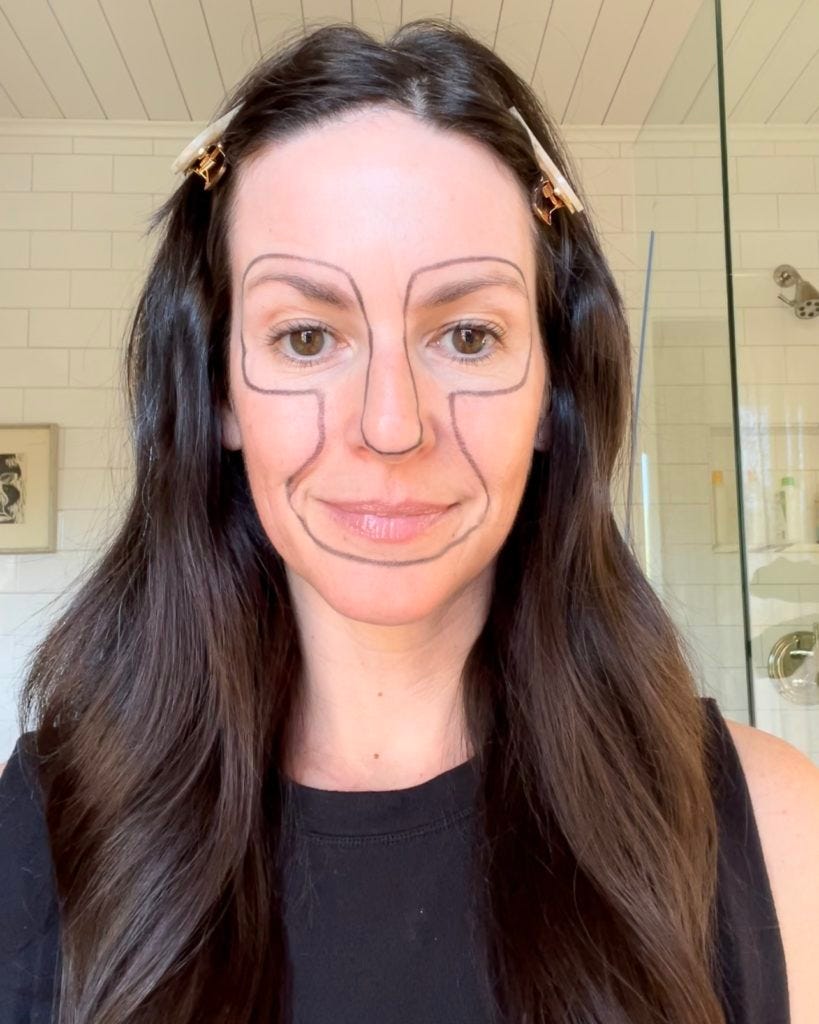I’ve used over-the-counter retinol products nightly for years (I still believe that this is the best retinol I've tried) and they've worked absolute wonders for my skin. Honestly, I will be using a retinoid until the day I die, forever and ever amen. However, I recently became super curious about upping my retinoid game to Tretinoin, a prescription-strength retinoic acid.
Update: I'm back to using OTC retinol - I prefer a gentler approach to my nightly retinol routine.
Wait wait wait, let's back up for a second. Retinoids, retinol, retinal, retinoic acid...what does it all mean?! Let me give you a little primer on all things retinoid.
What are retinoids?
Retinoids (which is the umbrella term for most topical vitamin A–based drugs) are the most studied anti-aging compounds, as I’m sure you’ve heard of Retin-A, which was the first retinoid. Originally used as an acne treatment in the 70s, researchers soon discovered that it also evened pigmentation, sped up the turnover of superficial skin cells, and reduced fine lines and wrinkles.
How, you ask? Well, retinoids increase the production of collagen, as well as stimulating the production of new blood vessels in the skin which improves the skin’s overall look. It usually takes about 3 months of regular use to see results, and the best results are usually seen between 6 and 12 months.
There are all different strengths and types of retinoids – prescription formulas usually contain retinoic acid, and nonprescription alternatives (such as retinol) need to be converted into retinoic acid by the skin at the cellular level. Retinol is more gentle than retinoic acid and retinaldehyde falls in between the two, but it’s important to note that the end results are usually the same…it just takes retinol and others longer to achieve the same results as retinoic acid. There are also weaker retinoids such as retinyl palmitate, retinyl acetate, and retinyl linoleate, which are the most gentle.
Here's a great visual on the differing strengths of retinoids.
image source: 101.skin
Bottom line: Retinoic acid is the most potent form of retinoid, but it’s also the most irritating. Retinol falls in the middle — it isn’t as strong as retinoic acid, but it still improves skin appearance while generally causing less irritation. Most importantly, all retinoids ultimately deliver similar results; with the gentler ones, it just takes more time.
A note for all my fellow African Botanics Cell Resurrection Serum junkies - if you have been using it for over a year and want to up your game without getting a prescription, I highly recommend trying the African Botanics Retinal Night Cream, which contains 0.1% retinaldehyde and is formulated for more experienced retinoid users.
We good? Okay, moving right along. Now that I've been on Tret for a couple of months, I can attest that it is indeed WAY stronger than the retinol serums I've used in the past. Where I could jump right in with my OTC retinol serums, a much more careful approach should be taken when using retinoic acid. Here are my tips!
Tips for Using Retinoids
1. GO SLOW
Considering you will probably be using a retinoid for years to come, there’s no reason to rush - especially with Tret or other prescription-strength retinoids. I am still only using Tret 3/week.
As for gentler OTC retinol products (like Cell Resurrection Serum), you can apply much more frequently with no issue. (After an intial testing period, of course.)
I started with Tret 1x/week for a couple of weeks, then bumped it up to 2x/week for a few weeks, and then 3x/week. I experienced minimal redness and peeling while following this schedule.
I personally continue with the African Botanics Cell Resurrection Serum on the nights I do not use Tretinoin. This works fine with my skin, however, it might be different for you. A conversation with your dermatologist would be best to tailor your specific approach.
2. A LITTLE GOES A LONG WAY
A pea-sized amount is all you need for your entire face. A pea-size, you say? How am I going to spread that little of product over my entire face? Well, this is where Dr. Ranella Hirsch has you covered. This primer is super helpful on how to divvy up your retinol.
When applying, you might consider steering clear of the eye area and around the nose and mouth if you are sensitive.
Look! I drew you a face map! #becauseofcourseidid
I do not put Tretinoin inside those markings, which is basically around the eyes, nose, and mouth. The interesting thing about skin absorption is that products don't penetrate in a perfectly linear line. They spread within the skin, so even though I'm not actively rubbing next to my nose, a little bit of the product is still migrating. (I personally know this as a fact because I experienced peeling around those areas.)
So if you are concerned about fine lines and wrinkles around your eyes and mouth, don't worry because the product is still reaching those areas.
MOISTURE SANDWICH
Moisturizer + Retinoid + Moisturizer
Retinoids are usually directed to be applied to clean, dry skin and many people use this method with success. However, I have really dehydrated skin that always feels tight after cleansing, so applying Tret on already tight skin and waiting for it to absorb before applying moisturizer was slightly torturous for me.
Never fear! You can apply moisturizer before and after the retinoid - thus making a moisture sandwich. This is also excellent for sensitive skin types because it's a gentler approach.
I always let my moisturizer sink in before applying the Tretinoin - usually about 10-15 minutes. Currently, my favorite moisturizer for this method is Dieux Instant Angel.
SPF IS CRUCIAL
If you are leaving here with one takeaway, let it be this. You simply must use sun protection while using retinoids.
It’s virtually pointless to use a retinoid if you aren’t going to protect your face with SPF. Think about it - many of us are using a retinoid to improve skin issues caused by sun damage, but not wearing SPF just equals more sun damage. You’re basically canceling the two out and wasting your money, plus your skin will be more sensitive to the sun while using a retinoid. So slather up!
You can read about my very favorite sunscreens here.






Would you be willing to expand on your decision to stop using tretinoin? I'm on the fence.
I’ve honestly been surprised how easily my skin took to prescription strength tretinoin! But on the flip side my wife, whose skin is generally much less sensitive than mine, never could get past the irritation stage and is back to otc retinol. (I live on the edge so I put a bit of rest straight on my lips and under my eyes, which has been shockingly fine. But I know your technique/advice is the responsible approach ❤️)